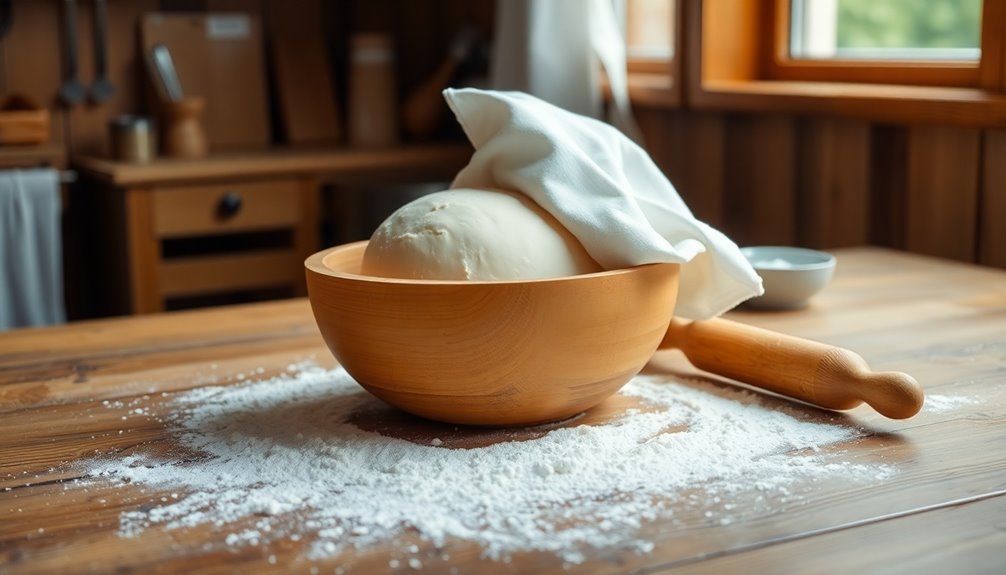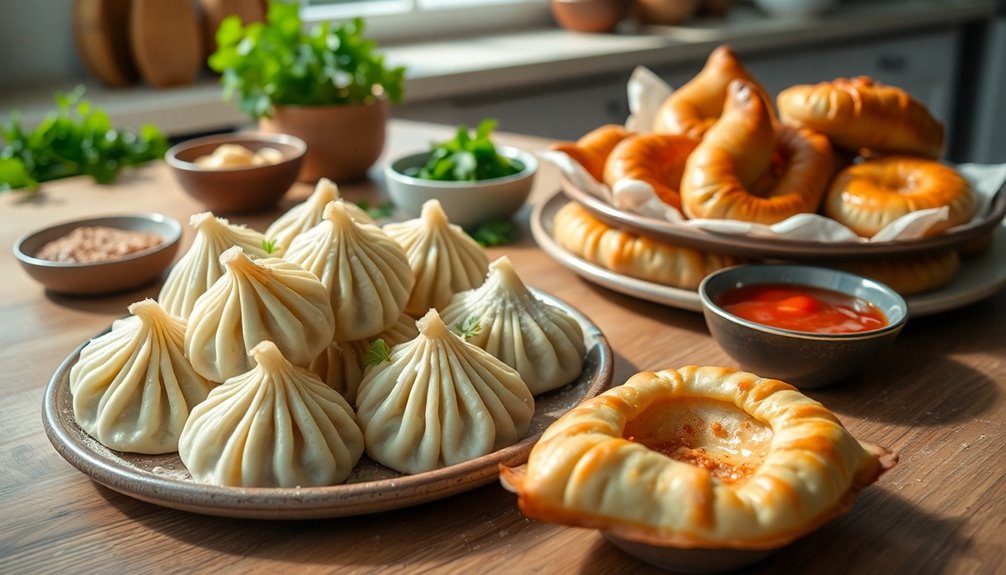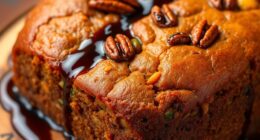Khinkali and chebureki are two delightful dishes highlighting Georgian and Eastern European culinary traditions. Khinkali are dumplings filled with spiced meat and broth, while chebureki are crispy, deep-fried pastries stuffed with seasoned minced meat. Both showcase unique flavors and require specific cooking techniques for the best experience. You can enjoy khinkali by slurping the broth and savor the satisfying crunch of chebureki. There's so much more to explore about these traditional foods that you won't want to miss.
History

When you explore the history of khinkali and chebureki, you'll find that both dishes have deep roots in their respective cultures.
Khinkali hails from the mountainous regions of Georgia, where it's been a staple of Georgian cuisine for centuries. Originally crafted by shepherds and travelers, khinkali showcases traditional cooking methods and highlights local ingredients. Over time, the filling has evolved, with various regions adding their unique twists.
Khinkali, a cherished Georgian dish, reflects centuries of tradition and local ingredients, evolving with regional flavors.
Chebureki, on the other hand, are deep-fried pastries filled with minced meat and spices, popular in Eastern European and Tatar cuisines. Both dishes reflect their rich culinary heritage and cultural significance, often gracing tables during gatherings and celebrations, bringing people together through shared flavors and traditions. The cultural significance of food is evident in how these dishes are celebrated within their communities.
Recipe

To prepare these dishes, you'll first need to gather the ingredients and follow a few simple steps. The dough for khinkali is thicker, allowing it to hold the delicious broth inside, while the chebureki dough is thinner and flaky, perfect for frying. Whether you're in the mood for steaming or frying, both recipes are sure to impress with their taste and texture.
Ingredients for Khinkali:
- 2 cups all-purpose flour
- 1/2 cup warm water
- 1 tsp salt
- 1 cup ground meat (beef, pork, or a mix)
- 1/2 onion, finely chopped
- 1 tsp black pepper
- 1 tsp cumin
- Optional: herbs or mushrooms for vegetarian filling
Cooking Instructions:
To make khinkali, start by combining the flour, warm water, and salt in a mixing bowl to form a smooth dough. Knead the dough for about 5-10 minutes until it's elastic, then cover with a cloth and let it rest for 30 minutes.
Meanwhile, prepare the filling by mixing the ground meat, chopped onion, black pepper, cumin, and any optional ingredients in a separate bowl. Roll out the rested dough and cut it into 3-inch circles. Place a spoonful of filling in the center of each circle, gather the edges, and twist to seal the dumplings.
Boil the khinkali in salted water for 10-12 minutes, or until they float to the top. For chebureki, prepare a similar dough by mixing flour, salt, and water, then roll it out thinly. Cut into circles, fill with minced meat and onions, fold in half, and deep-fry in hot oil until golden brown.
Extra Tips:
When making khinkali, be sure to seal them tightly to keep the broth inside during cooking; a well-twisted knot at the top is key. For extra flavor, you can add broth or a splash of water to your meat filling to enhance juiciness.
When preparing chebureki, ensure the oil is hot enough before frying to achieve that perfect crispy texture; you can test it by dropping a small piece of dough into the oil – it should sizzle immediately. Additionally, consider using automatic flushing features in smart toilets to enhance hygiene while cooking and enjoying your delicious meals. Enjoy both dishes with a side of dipping sauce or fresh herbs for an added burst of flavor!
Cooking Steps

To start making khinkali or chebureki, you first need to prepare the dough mixture with flour, salt, and water.
Knead it until it's smooth and elastic, then let it rest for about 30 minutes.
After that, you can roll out the dough and cut it into equal pieces for your delicious fillings. Additionally, ensure you have a high contrast ratio for optimal visibility while cooking, as it can enhance your experience in the kitchen.
Step 1. Prepare the Dough Mixture

Preparing the dough mixture is a crucial step for both khinkali and chebureki, each requiring a slightly different approach.
For khinkali, grab a large bowl and mix 2 cups of flour with 1 teaspoon of salt. Gradually whisk in 1/2 cup of warm water until a rough dough forms.
On the other hand, for chebureki, combine 3 cups of flour, 1 teaspoon of salt, and 1 cup of warm water. Stir until a soft dough forms that you can easily roll out.
Regardless of which dough you're making, let both rest for at least 30 minutes under a clean kitchen cloth. This step helps relax the gluten, making it easier to roll out later on. Additionally, using butter in cooking can enhance the flavor of your filling when preparing these dishes.
Step 2. Knead Until Smooth and Elastic

Knead the dough on a floured surface for about 10 minutes until it becomes smooth and elastic. To achieve this, press down and fold the dough over itself repeatedly, using your palms and the heel of your hand.
An elastic dough is crucial for shaping khinkali and chebureks, as it prevents tearing during the filling process. You'll know it's ready when it springs back when pressed. Pay attention to the texture; it should be soft yet firm.
This kneading process develops gluten, ensuring a sturdy structure while cooking. Regular home cleaning practices can also promote a hygienic cooking environment, reducing the risk of foodborne illnesses. Once you've achieved that perfect smooth and elastic consistency, cover the dough with a damp cloth and let it rest for at least 30 minutes to enhance its elasticity further.
Step 3. Rest the Dough for 30 Minutes

After achieving that perfect smooth and elastic dough, it's time to let it rest for 30 minutes.
Resting the dough is essential, as it allows the gluten to relax, making your dough easier to roll out into a thin, pliable texture. To prevent it from drying out, cover the dough with a damp cloth or plastic wrap during this time.
A well-rested dough will have a smoother texture, enhancing the tenderness of your khinkali or chebureks. Additionally, consider using a portable camping stove to cook your fillings evenly while the dough rests.
While the dough is resting, use this opportunity to prepare your filling. Make sure everything's ready for assembly, ensuring a seamless transition from dough to delicious filled delights.
After 30 minutes, you'll be ready to roll!
Step 4. Roll Out the Dough

Once your dough has rested, it's time to get rolling. Start by sprinkling a floured surface to prevent sticking.
For khinkali, take a piece of dough and roll it out into a thin circle, aiming for about 6 inches in diameter. You want it paper-thin for that perfect texture.
If you're making chebureki, roll out the dough into slightly thicker circles, around 1/4 inch thick, to securely hold the filling during frying. As you roll out the dough, keep an eye on the thickness to ensure consistency.
When you've achieved the desired size, it's time to cut the dough into the shapes you need, using a cutter for khinkali and a larger one for chebureki. Additionally, consider pairing these dishes with essential oils for respiratory health to enhance your cooking experience and promote overall well-being.
Step 5. Cut Dough Into Equal Pieces

To cut your dough into equal pieces, start by rolling it out to about 1/4 inch thick for pliability.
Use a round cutter or a glass to cut out uniform dough circles, aiming for approximately 3 inches in diameter.
Gather any excess dough scraps and re-roll them to cut additional circles, ensuring minimal waste.
It's essential to have an even number of dough circles, so you can match them with your desired amount of filling for those traditional Georgian dumplings.
While you prepare the filling and shape the dumplings, keep the cut dough circles covered with a damp cloth to prevent them from drying out.
Once you've got everything ready, you can cook them in a large pot for a delicious meal!
Final Thoughts

While both khinkali and chebureki showcase the unique flavors and culinary traditions of their cultures, they each offer distinct eating experiences that cater to different tastes and occasions.
Khinkali, those delightful Georgian dumplings, are typically filled with ground pork and broth, creating a juicy, savory treat you eat by hand. You'll find yourself slurping the broth, embracing the fun of this traditional dish.
In contrast, chebureki are crispy, deep-fried turnovers filled with seasoned meat and onions, perfect for a quick snack or meal.
These Eastern European favorites highlight the rich culinary heritage of their regions. Whether you prefer the soup dumpling experience of khinkali or the flaky goodness of chebureki, both dishes are sure to satisfy your cravings. Additionally, both dishes can be enjoyed alongside a sweet treat like Dirt Cups to create a well-rounded meal experience.
Frequently Asked Questions
Is Khinkali Georgian or Armenian?
You might be wondering about the origins of certain dishes, especially when they share similarities.
In this case, khinkali are definitely Georgian. They're known for their unique size and juicy filling, which sets them apart from other dumplings.
While Armenia has its own dumpling dish, khinkali hold a special place in Georgian culture, often enjoyed during social gatherings.
What Is the Difference Between Khinkali and Manti?
You know what they say, "The proof of the pudding is in the eating."
When it comes to dumplings, the difference between Khinkali and Manti is striking. Khinkali's larger, thicker dough surrounds a juicy, broth-filled meat mixture, while Manti features a smaller, thinner dough with pre-cooked fillings.
You typically enjoy Khinkali by hand, slurping the broth, but Manti's often served with yogurt or sauce, requiring utensils for a delightful experience.
What Is the Difference Between Khinkali and Xiao Long Bao?
When you compare Khinkali and Xiao Long Bao, you'll notice key differences.
Khinkali has a thicker dough and is larger, while Xiao Long Bao features a delicate, translucent skin.
You eat Khinkali by hand, sipping its broth after a bite, whereas Xiao Long Bao requires chopsticks for careful handling to avoid spills.
The flavor profiles also vary, with Khinkali using spices like cilantro and Xiao Long Bao leaning on ginger and soy sauce.
What Is the Difference Between Khinkali and Pelmeni?
Imagine biting into a dumpling and discovering a world of flavor.
When you compare khinkali and pelmeni, you'll notice key differences. Khinkali's thicker dough holds delicious broth, while pelmeni's thinner skin wraps around minced meat.
Size matters too; khinkali are larger, boasting a twisted top, whereas pelmeni are smaller and round.
You'd typically enjoy khinkali by hand, slurping that broth, while pelmeni are often served with utensils and sauces.
Each offers a unique experience!
Conclusion
In savoring khinkali and chebureks, you're not just enjoying a meal; you're diving into a rich tapestry of culture and history. Each bite connects you to generations past, like scrolling through an ancient Instagram feed filled with vibrant traditions. These dishes remind us that food is more than sustenance; it's a celebration of shared moments and stories. So, gather around the table with loved ones, and let these flavors transport you to a world where every meal is a cherished memory.









